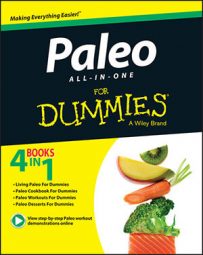The advice about good nutrition can be very confusing. How do you know what you need for a Paleo diet? Well, that can be tough to decipher. Just browse the magazine covers at the checkout stand to see all the conflict: low-carb, no-carb, low-fat, vegetarian, vegan, no fruit. What’s next — no food? No air?
The USDA Food Guide Pyramid can take much of the blame, even though it’s been several years since the pyramid was the prevailing guideline for how to eat. Here are some of the biggest problems with the food pyramid:
The base of the food pyramid is cereal, bread, and pasta — and a lot of it, to the tune of 6 to 11 servings per day. These processed carbs are unfavorable sources of energy and, more important, your body does not require these foods to operate efficiently. Additionally, antinutrients are found in whole grains, called phytic acid and lectins.
Phytic acid binds to minerals, making them unavailable for you to use. This means that the more whole grains you eat, the less able your body is to take advantage of minerals like calcium, magnesium, and zinc.
Lectins may cause even more trouble. These tricky guys bind to insulin receptors, which can lead to insulin problems, are linked to inflammatory problems, and damage your gut defenses that line your intestines. When you damage this lining, it allows food particles to enter into the blood system and lymph system, where they don’t belong. Digestion becomes compromised along with your immune system — not very appetizing!
The USDA food pyramid identifies whole grains as a good source of fiber. Here’s the real skinny: non-starchy veggies and fruits often have more than double the amount of fiber as grains. With the Paleo plan, you have no recommended daily allowance (RDA) for breads, pasta, and cereals. In fact, not only does your body not require these grains, but also your insulin and blood sugar management is better — so you’re healthier and happier — without them.
The food pyramid identifies dairy as a key component of good nutrition, but cow’s milk is the number-one food allergen for humans. That’s because cow’s milk isn’t intended for human consumption; it’s the perfect food for transforming calves into very large cows. Your body just doesn’t know what to do with milk — and ailments like digestive disturbance, acne, insulin resistance, and allergic reactions are the result.
Studies show that milk isn’t as protective to bone tissue as once thought — and contrary to popular belief, milk does not reduce bone fractures! To form and maintain strong bones, your body needs to be in pH balance; the fruits and vegetables in the Paleo diet put it right where it needs to be.
The food pyramid missteps with protein, too. Dried beans and peas can’t be eaten interchangeably with animal proteins like meat, poultry, fish, and eggs. Beans and legumes have poor digestibility and don’t pack the same complete protein punch as animal sources. In fact, beans and legumes averaged about 20 to 25 percent lower than animal protein ratings in a protein quality index published by the Food and Agriculture Organization/World Health Organization.
Beans and legumes contain about three times less protein than animal sources — and the incomplete proteins found in legumes are difficult for your body to digest.
In 2010, the USDA developed the next generation of food guidelines called MyPlate. These guidelines suffer from the same challenges as the food pyramid: Whole grains and dairy are still included requirements for health. The plate approach doesn’t solve the old problems. Instead, our actual plates should represent what has been discovered from evolutionary science.
![[Credit: Illustration © U.S. Department of Agriculture]](https://www.dummies.com/wp-content/uploads/472622.image0.jpg)

